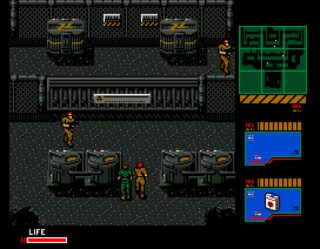
Author: Tasha - Published: 30 January 2017, 5:00 pm
Metal Gear 2: Solid Snake is a top-down stealth action game developed and published by Konami and released in 1990. It was written and designed by Hideo Kojima, who also designed the MSX2 version of the original Metal Gear.
Strangely enough, Konami started the development of a sequel of Metal Gear, called Snake's Revenge, without informing Hideo Kojima. When he discovered it, he decided to create his own sequel, Metal Gear 2. Unfortunately this was released in Japan only, where MSX was still popular in 1990 (while Snake's Revenge was released in USA and Europe only). This is the reason why an official English version of Metal Gear 2 does not exist. However GamesNostalgia has patched the game with a fan-made update, and packed everything with an MSX emulator so that you can fully enjoy this amazing game.
Read More
Author: Tasha - Published: 30 January 2017, 6:43 am
Skyroads is a remake of the driving game Kosmonaut. Both games were made by Bluemoon, a small studio based in Estonia. The game was released in 1993 for PC MS-DOS only.
Compared to Kosmonaut, Skyroads is much more polished and it has better gameplay and graphics. It can be considered a driving game, not racing. There are no other vehicles seen on the roads. The vehicle the player is using is a star glider. There are 30 roads that are placed over 10 areas. The player has to either avoid or aim for different colored tiles to be able to complete the game. The end of the game comes when the glider is finally in space after going through a tunnel. The player also had to watch the amount of gravity that they are in. The glider could either be in a weightless environment or in will be so heavy there is no jumping.
Read More
Author: Tasha - Published: 30 January 2017, 3:46 am
Descent II is a first person shooter published in 1996. It's the sequel to Decent. The game was published by Interplay Productions and developed by Parallax Software. Originally intended as an expansion pack for Decent, it grew into its own game. Initially published for DOS, it has since been ported to Windows, Mac OS and Playstation.
As in its predecessor Descent, players inhabit the character of the “Master Defender” a mercenary tasked with destroying mines for the Post-Terran Minerals Corporation. The game gives you 720 degrees of movement. It also puts you in control of the “Pyro-GX” Spaceship. Your main goal is to locate and destroy each mine's reactor. There's a guide bot that helps to guide you to the reactor. You destroy it with an array of weapons like the Plasma Cannon, the Fusion Cannon, the Spreadfire Cannon, the Vulcan Cannon and more. The soundtrack employs industrial metal music from artists like Type O Negative and Brian Luzietti.
Read More
Author: Tasha - Published: 29 January 2017, 6:31 pm
The Settlers is a medieval city-building simulation game by Blue Byte Software, first released in 1993 for Commodore Amiga and in 1995 for MS-DOS. In America, it was published as Serf City: Life Is Feudal.
It took over two years to code the game to understand supply and demand.
The game is set in a cartoony version of medieval times. You must manage and obtain resources like wood, stones, pork, fish, bread, iron, coal, and gold. The game's goal is to defeat your enemies and take their territory. It's a real-time strategy game. The Settlers features 30 ready-made missions, as well as semi-randomly generated maps. Two-player games may be played both online and offline.
Read More
Author: Tasha - Published: 29 January 2017, 8:33 am
Mega Man X is a popular platform game developed by Capcom, released for the SNES in 1993 and ported to PC in 1995.
It holds the distinction of being the first Mega Man game for the SNES, as well as the first game in the Mega Man X series. The Mega Man X series is a spin-off of the popular Mega Man series. The game was released in 1993, and has since been ported and remade on other platforms like Playstation 2, Gamecube, MS-DOS, Mobile Phones, Playstation Portable, and PC.
Read More
Author: Maddie - Published: 29 January 2017, 5:40 am
Double Dragon is a beat them up created by Technos Japan and released in 1987 by Taito. Originally released as an arcade game, versions were also made for home computers and consoles, including Amiga, NES, Atari ST, DOS, Atari 2600, Commodore 64, and ZX Spectrum.
The player controls brothers Billy and Jimmy Lee, who set out to use their training in the martial art of Sou-Setsu-Ken to rescue Billy’s girlfriend Marian after the notorious Black Warriors gang kidnaps her.
Read More